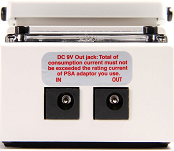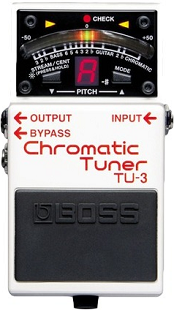Difference between revisions of "TU-3"
| Line 2: | Line 2: | ||
| __TOC__ | | __TOC__ | ||
|} | |} | ||
| − | [[Boss]] TU-3 Chromatic Tuner. The TU-3 is an advancement the previous TU-2. The TU-2 was itself was a reimagining of the Boss TU- | + | [[Boss]] TU-3 Chromatic Tuner. The TU-3 is an advancement the previous TU-2. The TU-2 was itself was a reimagining of the Boss TU-12 Chromatic Tuner. However, the TU-3 Chromatic Tuner took the TU-2's tuning functions and improved upon the TU-2 by including the enhanced tuning range of the TU-12h "High Range Chromatic Tuner". The TU-12 and TU-12h housed conventional tuners that used bouncing needles in-a-VU-meter in a plastic case. The TU-12/12h originally fit near the handle area of the Boss 6-pedal-unit, the BCB-60. These previous electronics served as the platform on which the Boss TU-2 pedal was built, and in-turn the TU-3. |
; Boss tuning device release dates | ; Boss tuning device release dates | ||
| Line 11: | Line 11: | ||
==Controls== | ==Controls== | ||
| + | [[File:Boss_TU3_top.png|right|frame|<div style="text-align:right">Image from [https://www.andertons.co.uk/guitar-dept/guitar-pedals/tuners-metronomes/boss-tu-3-compact-chromatic-tuner Anderton's Music]</div>]] | ||
[[File:Boss_TU3_front.png|right|frame|<div style="text-align:right">Image from [https://express.google.com/product/15444679833231883223_17406260260932355660_1699011 Google Express]</div>]] | [[File:Boss_TU3_front.png|right|frame|<div style="text-align:right">Image from [https://express.google.com/product/15444679833231883223_17406260260932355660_1699011 Google Express]</div>]] | ||
| Line 62: | Line 63: | ||
| − | ===Sun- | + | ===Sun-Glare Display=== |
If playing outdoors in sunlight, it's possible to turn up the LED brightness in order to see the tuning indicator despite sun glare. Hold down Button 1, the "Stream / Cent" button for 2 seconds. The tuning indicator section will briefly display 5-6 vertical bands to indicate you're in high-brightness mode. To revert to standard brightness, hold down Button 1, the Stream / Cent button, again for two seconds, and the TU-3 will again display the tuning indicator in standard brightness. | If playing outdoors in sunlight, it's possible to turn up the LED brightness in order to see the tuning indicator despite sun glare. Hold down Button 1, the "Stream / Cent" button for 2 seconds. The tuning indicator section will briefly display 5-6 vertical bands to indicate you're in high-brightness mode. To revert to standard brightness, hold down Button 1, the Stream / Cent button, again for two seconds, and the TU-3 will again display the tuning indicator in standard brightness. | ||
| + | |||
==Pedal Manual== | ==Pedal Manual== | ||
https://static.roland.com/assets/media/pdf/TU-3_e04_W.pdf | https://static.roland.com/assets/media/pdf/TU-3_e04_W.pdf | ||
| + | |||
==Phase Inversion: No== | ==Phase Inversion: No== | ||
| Line 72: | Line 75: | ||
==Schematic== | ==Schematic== | ||
| − | The Boss TU-3 has no schematic that we've been able to obtain. The closest schematic that we've been able to | + | The Boss TU-3 has no schematic that we've been able to obtain. The closest schematic that we've been able to muster is from the TU-2. Since the circuitry for the TU-2 is an antecedent to the TU-3, we've included it to aid in possible trouble-shooting. |
| + | |||
| + | |||
==Artists== | ==Artists== | ||
Revision as of 00:50, 21 August 2018
Boss TU-3 Chromatic Tuner. The TU-3 is an advancement the previous TU-2. The TU-2 was itself was a reimagining of the Boss TU-12 Chromatic Tuner. However, the TU-3 Chromatic Tuner took the TU-2's tuning functions and improved upon the TU-2 by including the enhanced tuning range of the TU-12h "High Range Chromatic Tuner". The TU-12 and TU-12h housed conventional tuners that used bouncing needles in-a-VU-meter in a plastic case. The TU-12/12h originally fit near the handle area of the Boss 6-pedal-unit, the BCB-60. These previous electronics served as the platform on which the Boss TU-2 pedal was built, and in-turn the TU-3.
- Boss tuning device release dates
- 1982: TU-12 Chromatic Tuner unit
- 1990: TU-12h High-Range Chromatic Tuner unit
- 1998: TU-2 Chromatic Tuner pedal
- 2010: TU-3 Chromatic Tuner pedal
Controls


- Button 1 - "Stream / Cent": At first glance, this button toggles between "Stream" and "Cent" tuning methods, but there's a lot more functionality described below.
- Button 2 - "Mode": At first glance, this button toggles between
- Tuning for Bass or Guitar
- Setting the number of steps or half-steps below standard tuning you may wish to tune your instrument
- Footswitch 1 - "Active/Bypass": Toggles the function of the pedal between "on" and "off". How this footswitch works is dependent on the output jack used.
Jacks
- Output 1 - "Output": When this output jack is used, toggling the footswitch will turn the signal on or off. The signal will be "on" for when the tuner is not engaged or in use, and the signal will be "off" when the pedal is being used to tune. Use this when you don't want people to hear you tuning up.
- Output 2 - "Bypass": When this output jack is used, using the footswitch on the TU-3 only turns the function of the tuner on and off. That means that whether the tuner is on or off, the instrument signal will always be going out on this jack. Use this when you don't care about people hearing you tune up.
- Power In - Standard 9-volt barrel-negative tip Boss-style power supply
- Power Out - The TU-3 *can* power other pedals if using a daisy-chain cord of Boss-style barrel-negative tip terminals, provided those other pedals use the same AC adapter
- Note
- There's nothing stopping a musician from using both output jacks at the same time. For example, it would certainly be possible to use the Bypass jack as a "direct out" for re-amping while using the Output during a live concert.
Bypass:Buffered
Like all Boss pedals, the TU-3 has a buffered bypass.
General Information
The TU-3 begins at power-on in the "Chromatic" mode for tuning. Using this mode is simple enough: play a note, and the pedal will detect the note, and show which note is being played in the digital display. Pressing the "Mode" button at that point will advance right-to-left through the different tuning modes, as seen printed under on Tuning Indicator.
The TU-3 can handle tuning seven-string guitars, and 6-string bases.
- In Guitar mode, a musician can press the mode button again to select drop-tunings, all the way to 6 half-steps down.
- In Bass mode, a musician can tune down by 1 to 3 half-steps.
Tuning Indicator
The Tuning indicator is the LED-filled arc seen spanning the face of the pedal above the digital display showing the note pitch. There are two tuning modes and both work well, they're just configured differently to cater to different player preferences.
"Cent" Tuning
In this tuning mode, the lights act in a manner corresponding to a needle in a VU meter. The more extremely flat or sharp that the note detected by the TU-3 is the further the light representing needle will be from the center of the tuning indicator.
- If the light-needle on the meter is on the left side of the tuning indicator, the note played is flat and needs to be made sharper;
- If the light-needle is floating on the right side of the tuning indicator, the note played is sharp and needs to be flattened.
- Once and when the note played is in-tune, the light-needle will hover in the center of the tuning indicator. A couple of lights from each side of the tuning indicator will converge in the center of the tuning indicator, and the light of the indicator will change from red to yellow-green, indicating that the note is tuned properly.
"Stream" Tuning
While there is no strobe or strobe-simulator used by the TU-3 to pitch-match, in this tuning mode, once a note is sounded, the lights in the tuning indicator behave like a strobe tuner. The flatter or sharper that notes are tuned, the faster the lights on the tuning indicator will rotate. As the note gets closer to the correct pitch, the rotation of the lights will slow down.
- If the lights rotate clockwise when your note is played, then the note is flat and needs to be tuned sharper;
- If the lights rotate counter-clockwise when the note struck, then the note is sharp and needs to be tuned flatter;
- Once and when the note is tuned to pitch, the lights will all briefly halt and then converge at the center into non-moving yellow-green light indicating correct note pitch.
After having used either one of these tuning methods, the end result is the same: Your instrument is tuned!
Tuning Calibration
By pressing both buttons at the same time, it's possible to reset the tuning calibration of the TU-3. Default calibration is A=440, but the calibration can be set as low as A=436 and as high as A=445.
Sun-Glare Display
If playing outdoors in sunlight, it's possible to turn up the LED brightness in order to see the tuning indicator despite sun glare. Hold down Button 1, the "Stream / Cent" button for 2 seconds. The tuning indicator section will briefly display 5-6 vertical bands to indicate you're in high-brightness mode. To revert to standard brightness, hold down Button 1, the Stream / Cent button, again for two seconds, and the TU-3 will again display the tuning indicator in standard brightness.
Pedal Manual
https://static.roland.com/assets/media/pdf/TU-3_e04_W.pdf
Phase Inversion: No
Regardless of whether the "Output" jack or the "Bypass" jack is used, this pedal does not invert phase, as this pedal only inspects the signal going into it. It's not an effect that will change the signal. This means no phase inversion from the TU-3
Schematic
The Boss TU-3 has no schematic that we've been able to obtain. The closest schematic that we've been able to muster is from the TU-2. Since the circuitry for the TU-2 is an antecedent to the TU-3, we've included it to aid in possible trouble-shooting.
Artists
- Nuno Bettencourt
- Chris Cornell
- Billy Duffy
- Marty Friedman
- Paul Gilbert
- Scott Gorham
- Dave Grohl
- James Hetfield
- Gus G. (Konstantinos Karamitroudis)
- Johnny Marr
- J Mascis
- Duff McKagan
- Dave Navarro
- Nick Oliveri
- Buzz Osborne
- John Petrucci
- Matt Pike
- Alex Skolnick
- Slash
- Michael Sweet
- Steve Vai
- Brad Whitford
- Additional Sources